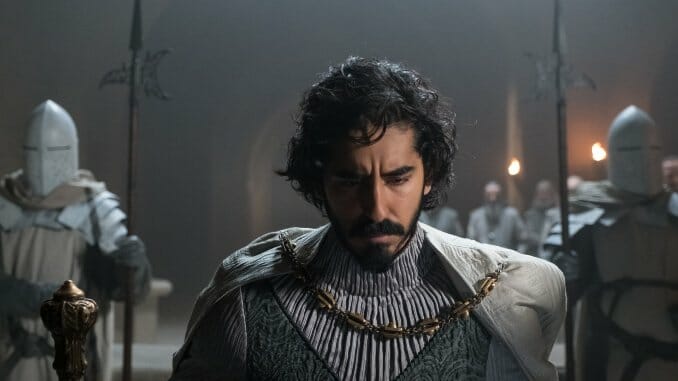The Green Knight, Failure, and Green, Green Growth

What is a romance without failure? There’s plenty of traditional and chivalric romance in writer/director David Lowery’s The Green Knight, and both mostly concern our poor Gawain (Dev Patel) screwing up. “Sir Gawain and the Green Knight,” a story about a man riding off to honorably lose his head, has always centered around a confrontation of hubris—an understanding that a moral code is only as strong as the Lancelot/Guinevere affair that breaks it and that a quest’s completion is only as honorable as the temptations to stray from its path. One of Lowery’s most moving narrative additions in his fantastic adaptation is an extended “What if?” sequence that finally enlightens our hero to a simple point: That to err is human, but growing brave enough to forgive oneself is divine.
![]()
Lowery’s work is effectively concerned with all the themes—magic, real and religious—of the original poem, but his unique climax brings them all under the thrall of his (and the text’s) interest in and appreciation of human fallibility. Gawain has been a medieval goober throughout the film—not quite a drunk but not not a drunk; a noncommittal lout towards his sex worker lover Essel (Alicia Vikander); greedy towards a ghost, which certainly shows chutzpah if not good judgment; weak in the face of sexual temptation—and the shames of these recognized foibles weigh on him. This isn’t how a good Christian, let alone a Knight of the Round Table, should be! It’s this disconnect, the youthful gap between ideal and reality, that sets the unproven Gawain off on his quest in the first place. An unwavering, dogmatic devotion to this false idea of perfection is his main adversary.
And he’s not incapable of change, or of true-blue heroism: Light peeks its way through the dusty dark of the haunted house in which he completes unfinished spectral business. Lowery gives us a tease of his playful stance towards time and possibility when Gawain’s tied up and robbed by Barry Keoghan’s merry band of ruffians. It’d be so easy, the filmmaking tells us, for Gawain to just sit there and die—to allow a single setback to skeletonize him. Then the camera spins back around and, sorry Alive Gawain, but you’re gonna have to deal with this. This is his first taste of consequence and, subsequently, his first chance to show a little knightly gumption and overcome it. So he does, as good intentions slowly become well-intentioned but flawed actions. While the Lady (also Vikander) ribs him (and us) for thinking that the completion of this quest will instantaneously deem him honorable, it is all Gawain can do to soldier forth—fleeing the seductive situation that led to his latest fuck-up in a flash of post-nut clarity—and attempt to make good on something, if not everything.
When he arrives to accept his decapitating chop from The Green Knight, he flinches. That makes sense. It’s scary as hell, and Lowery lets his actor play it with utter realism in order to deliver a more humanized point. Patel rattles his horny, proud, jittery, jumpy shell around the character’s steel core like he’s always about to have a heart attack. It’s at the performance’s nervous peak where Gawain could fail more, and more explicitly, than ever before. In the source, Gawain stays silent and takes a small nick on the neck because he doesn’t disclose the magical green sash promised to keep him alive. An act of cowardice. Lowery goes more cerebral.
-

-

-

-

- Curated Home Page Articles By Test Admin October 21, 2025 | 3:10pm
-

- Curated Home Page Articles By Test Admin October 21, 2025 | 2:57pm
- Urls By Test Admin October 21, 2025 | 2:57pm
- Curated Home Page Articles By Test Admin October 21, 2025 | 2:55pm
-

-

-

-

-

-

-

-

-

-

-

-

-

-

-

-

-

-

-

-

-

-

-

-

-

-

-

-

-

-

-




































